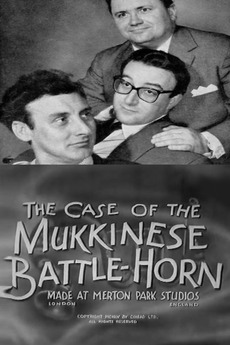The Case of the Mukkinese Battle-Horn
| The Case of the Mukkinese Battle-Horn | |
|---|---|
 | |
| Directed by | Joseph Sterling |
| Written by | Larry Stephens (original story and screenplay) Harry Booth (screenplay) Jon Penington (screenplay) Peter Sellers (additional material) Spike Milligan (additional material) |
| Produced by | Harry Booth Michael Deeley Jon Penington |
| Starring | Peter Sellers Spike Milligan Dick Emery |
| Cinematography | Brian Rhodes |
| Music by | Edwin Astley |
| Distributed by | Archway Film Distributors |
Release date |
|
Running time | 27 minutes |
| Country | United Kingdom |
| Language | English |
| Budget | £4,500[1] |
| Box office | £45,000[1] |
The Case of the Mukkinese Battle-Horn is a 30-minute comedy film starring Peter Sellers, Spike Milligan and Dick Emery. The film was made in November 1955, and released in 1956.[2][3]
Plot
Supposedly filmed in 'Schizophrenoscope' ("the New Split-Screen"), it concerns Superintendent Quilt of Scotland Yard's attempts to retrieve a 'Mukkinese Battle-Horn' stolen from a London museum. Along the way he meets characters not dissimilar to Eccles, Henry Crun and Minnie Bannister from The Goon Show.
Production
This attempt to adapt Goon humour to the big screen was written by Harry Booth, Jon Penington and regular Goon show co-writer Larry Stephens, from a story by Stephens, with additional material by Sellers and Milligan. Emery replaced Harry Secombe, who was too expensive for the film's low budget.
The budget of £4,500 was raised from Archway Film Distributors (£1,500); Peter Weingreen, who worked with Michael Deeley and Harry Booth on The Adventures of Robin Hood (£1,500); and Joseph Sterling, who wanted to direct (£1,500). Peter Sellers was paid £900.[1]
Release
The film was unable to secure a release in the US but screened widely as a supporting short in British cinemas. Michael Deeley says it remains the most profitable film he was ever associated with, returning its cost ten times over.[1]
Critical reception
The New York Times wrote "It is a good thing Mr. Sellers and his helpers didn't try to stretch it for longer than a half hour. But within that time and with reservations...it makes a lively little lark."[4]
References
- ^ a b c d Michael Deeley, Blade Runners, Deer Hunters and Blowing the Bloody Doors Off: My Life in Cult Movies, Pegasus Books, 2009 p 17-20
- ^ Scudamore, Pauline (1985). Spike Milligan: A Biography. London: Granada. ISBN 0-246-12275-7. p.173. Scudamore states the film was made by Richard Lester, but it is not clear from other sources that this was the case
- ^ Lewis, Roger (1995). The Life and Death of Peter Sellers. London: Arrow Books. ISBN 0-09-974700-6.
- ^ Crowther, Bosley (31 July 1962). "Screen: British 'Coming-Out Party':Comedy on Prisoners of War at the Plaza" – via NYTimes.com.
External links
- The Case of the Mukkinese Battle-Horn at IMDb
- The Case of the
Mukkinese Battle-Horn at AllMovie - Entire script for The Case of the Mukkinese Battle-Horn
- The Goons films at The Goon Show website
- The Goons films at The Telegoons website
- Copy of script
- Use dmy dates from April 2016
- Articles with invalid date parameter in template
- Use British English from April 2016
- Articles with short description
- 1956 films
- Template film date with 1 release date
- IMDb title ID not in Wikidata
- 1950s crime comedy films
- English-language films
- British black-and-white films
- British crime comedy films
- Works by Spike Milligan
- 1956 short films
- Comedy short films
- 1956 comedy films